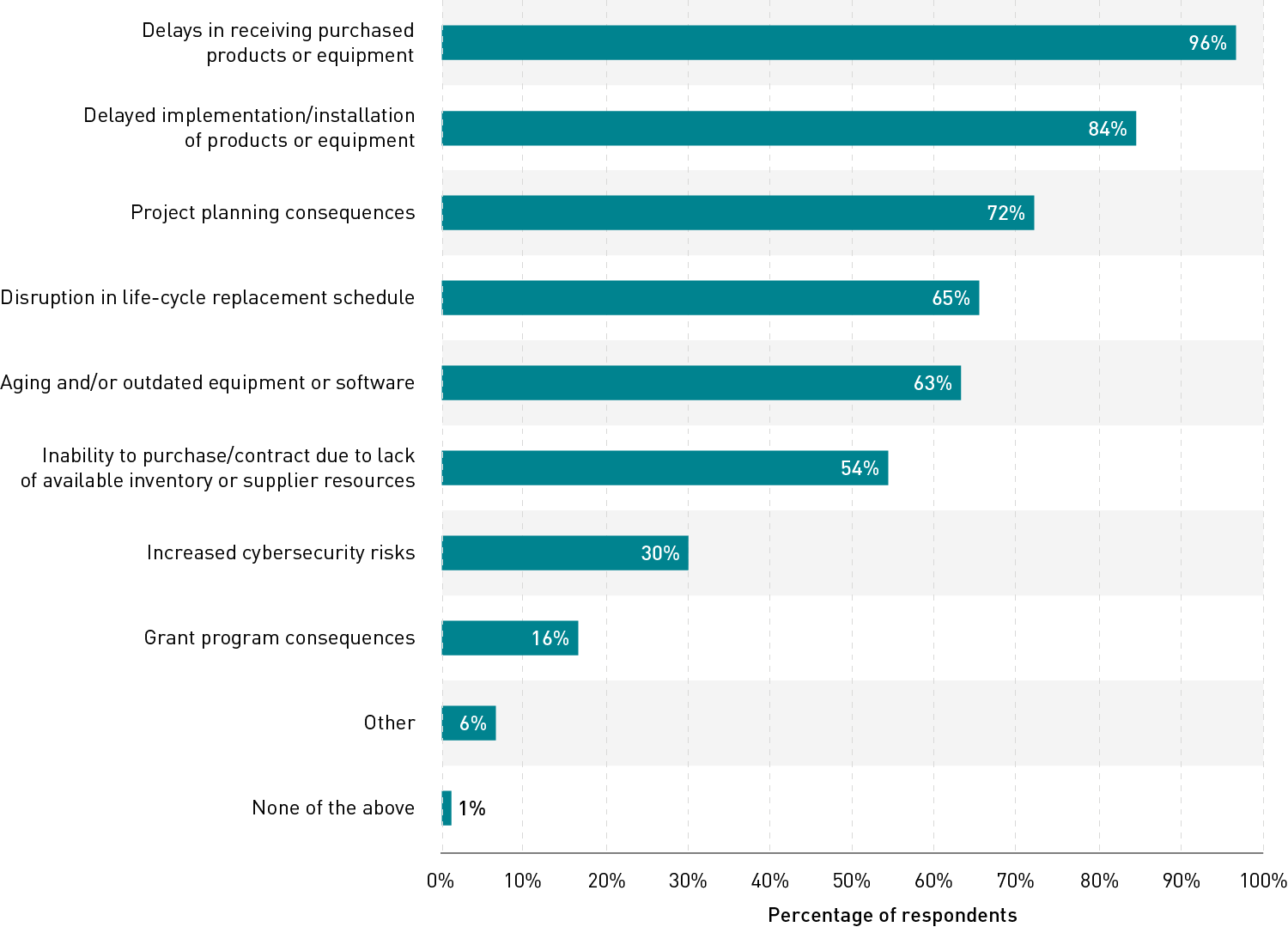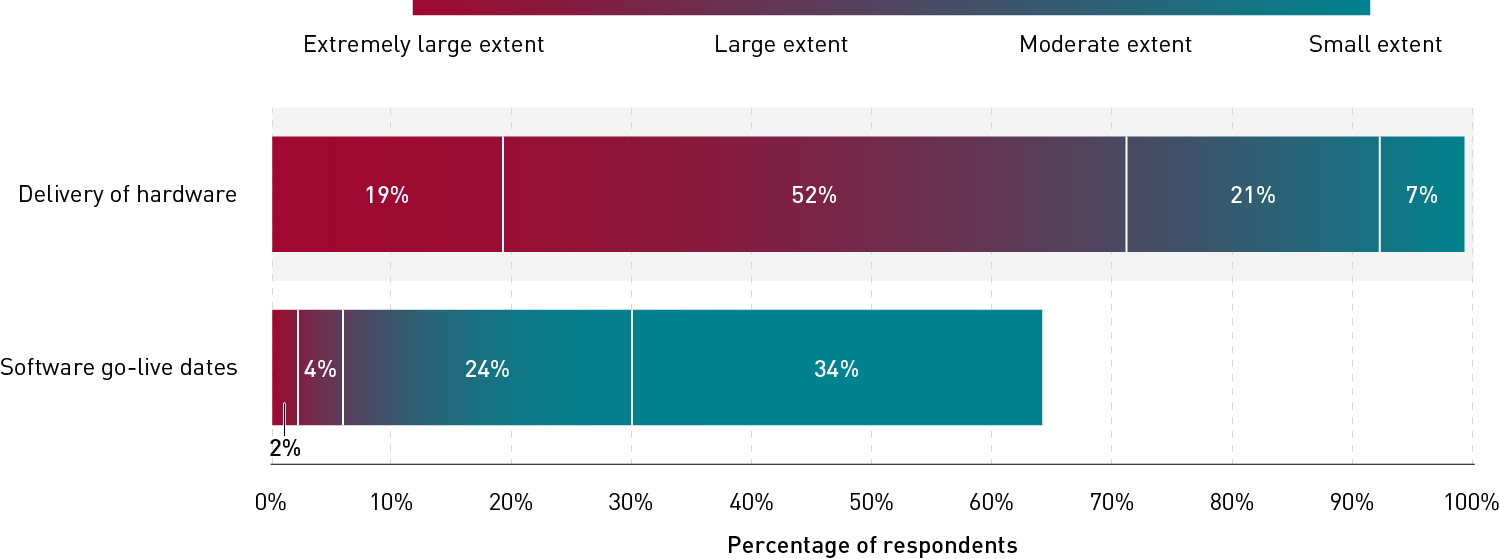As institutions and technology units continue to experience supply-chain disruptions that fall beyond their control, integrating flexibility into planning and procurement processes can enable the development of creative solutions to these challenges.

EDUCAUSE is helping institutional leaders, technology professionals, and other staff address their pressing challenges by sharing existing data and gathering new data from the higher education community. This report is based on an EDUCAUSE QuickPoll. QuickPolls enable us to rapidly gather, analyze, and share input from our community about specific emerging topics.Footnote1
The Challenge
As technology leaders balance the delivery of critical services with reduced budgets and staff, supply-chain disruptions are introducing a feeling of "two steps forward and one step back." The consequences from vendors' delays are being felt across campus, from project and fiscal planning to student-facing services. How might institutional and technology leaders minimize the impacts on operations and stakeholders and maintain expected service levels? Institutional resilience and flexible processes can enable the development of creative solutions to the supply-chain challenges that tend to fall beyond the control of technology units.
The Bottom Line
Survey respondents reported experiencing a multitude of challenges as a result of supply-chain disruptions. While nearly all institutions are taking some form of action in response to these challenges, there is an opportunity to increase institutional resilience and flexibility in planning and procurement processes in preparation for, and in response to, highly disruptive periods.
The Data: Challenges of IT Supply-Chain Disruptions
Supply-chain challenges are broad and deep. Respondents were asked to select which challenges they are currently experiencing due to supply-chain disruptions (see figure 1). Nearly all respondents reported delays in receiving purchased products or equipment (96%), and significant majorities reported challenges with delayed implementation/installation of products or equipment (84%) and project planning consequences (72%).
Nearly two-thirds of respondents reported challenges with life-cycle replacement schedules (65%) and aging and/or outdated equipment or software (63%), while slightly more than half of respondents are unable to purchase or contract due to lack of available inventory or resources (54%).
While some of these challenges are broader and more immediately apparent to stakeholders and institutional operations (i.e., physical equipment), other issues are deeper and less obvious (i.e., increased cybersecurity risks).
Which of the following challenges is your IT unit currently experiencing due to hardware or software supply-chain disruptions?

Disruptions in the IT supply chain affect the entire institution. When asked to provide additional explanation about how their institution is experiencing these supply-chain challenges, more than 50 respondents identified a multitude of consequences spanning across their campuses.Footnote2
Many reported extensive delays in receiving classroom equipment (namely audio/video), as well as network and infrastructure equipment. Institutions that are opening new buildings are being required to do so without full function, which duplicates the workload of technology teams in the long term. Facilities services are being impacted due to a lack of access-control technologies, which increases security concerns. Vendors are offering fewer technology options that align with institutional standards and are increasing costs, which impacts fiscal planning. In addition, the delivery time for equipment is unpredictable, ranging from four months to two years in unexpected delays, which conflicts with procurement processes.
"We're unable to complete the installation of technology in classrooms—impacting ability to deliver courses in multi modes."
"Some of our components such as A/V processors and wireless APs still have lead times of 12+ months. Using state funding, where items have to be received before FY-end, has been exceptionally challenging. Where possible, we build projects without components and will add them later, but other larger projects have been placed on hold. This is exceptionally challenging from an operational and planning perspective."
"Equipment we would ordinarily receive in 4-6 weeks can take 4-6 months, which makes project planning difficult. However, there are usually alternatives that are more readily available but that can impact institutional standards."
"Infrastructure equipment is suffering the most. We are backlogged by 2+ years on receiving equipment to finish projects. Failure has occurred, and without the replacement installed the vendors won't honor warranties."
"We're seeing increasing lack of reliability in terms of availability of core network equipment and long delays. This is causing increased prices for hardware, resulting in pressure on budget. We are now re-evaluating our single-vendor strategy for our network equipment, which as a Research 1 with a very large physical campus is undesirable in terms of complexity."
"We have found that the real problem is unpredictability. We will be told that something is scheduled to arrive on a certain (far out) date, but then it arrives without warning much earlier. This can disrupt planning almost as much as delays."
The Data: Impact of IT Supply-Chain Disruptions
Disruptions are impacting a variety of functional operations. Respondents were asked whether specific supply-chain disruptions are impacting their institution (see figure 2). Three-quarters of respondents reported that supply-chain disruptions are impacting their budgeting or fiscal planning (76%), and more than half reported impacts to student-facing services (59%). A sizable number of respondents also reported impacts to staffing or workforce (38%), and 16% reported that HEERF spending was being impacted.
Are supply-chain disruptions impacting the following areas at your institution?

In open-ended comments, respondents further described the ways in which supply-chain disruptions have impacted numerous areas of institutional operations. Most respondents reported issues related to problems in classroom functionality and difficulties in meeting institutional standards. The impacts on ability to meet institutional standards are wide-ranging, from procurement requirements and technology standards to service-level expectations of business units and other stakeholders. Other concerns include dealing with shortened warranty times and longer refresh cycles and securing funding in the current fiscal year to order equipment needed in subsequent fiscal years.
"A number of classrooms are nonfunctional for technology. We need to consider switching to nonstandard technology options."
"Renovations of learning spaces are being pushed out almost 9-12 months. Failing network equipment is unable to be replaced."
"We have a new building coming online in a year. We're buying product now to have it in a year—if it arrives earlier, the warranty starts and, in some cases, will expire before installation."
"As we are rewiring buildings for new network cabling, sometimes we have to reuse old equipment and then replace that with the new equipment when it arrives later. This results in a duplication of installation efforts. Otherwise, we've been borrowing equipment that arrived for another project that isn't getting executed until later, requiring more planning and tracking on logistics and accounting."
Respondents were also asked about the extent of the delays they are experiencing with hardware delivery and software go-live dates (see figure 3). Nearly all respondents reported that they are experiencing some delay with hardware delivery (99%), with 71% experiencing large or extremely large delays. Significantly fewer respondents reported delays in software go-live dates, with just 6% reporting large or extremely large delays.
To what extent is your institution experiencing supply-chain delays in delivery of hardware and in software go-live dates?

The Data: Responses to IT Supply-Chain Disruptions
Institutions are delaying projects, but flexibility in processes may help. Respondents were asked to select the actions their institution is taking in response to supply-chain disruptions (see figure 4). An overwhelming majority reported that they are prolonging implementation dates (91%), and roughly two-thirds reported that they are pushing projects to the next fiscal year (67%) and employing alternative solutions (64%). With only one-fifth of respondents managing project plans that enable them to go-live at a moment's notice (19%), there is significant opportunity for technology units and institutions to examine ways in which they can build institutional resilience to proactively plan for and ensure business continuity.Footnote3
What actions is your institution taking in response to challenges with supply-chain disruptions?

Twelve respondents also reported other ways in which their institutions are taking actions in response to IT supply-chain disruptions. Most provided comments related to purchasing equipment in advance, adjusting life-cycle timelines, and reallocating equipment from other projects (see figure 5).
Common Challenges
Throughout the survey, respondents consistently reported on delays or postponements of projects. While delays in delivery of equipment mostly fall beyond the control of institutions, in some cases delays were due either to the purchasing requirements of current budgeting and procurement processes or policies or to missed opportunities for just-in-time planning.
Related to the challenge of project delays is the duplication of efforts by technology, logistics, and accounting teams when a project is under way but then stalls and work must be repeated. As a result, extreme delays in the IT supply chain are impacting student-facing services, budget and fiscal planning, and the workforce.
Promising Practices
Necessity is the mother of invention. During a highly disruptive period, we have an opportunity to adjust processes and policies to achieve desired goals while also ensuring alignment with the institutional mission and values. Through budget and fiscal planning, institutions can explore ways to grant special exceptions to procurement processes, such as by allowing the spend to take place in one fiscal year for delivery in the following fiscal year and/or by adjusting procurement process and contract requirements such as vendor approval and quotes. Technology leaders can also further partner with stakeholders and procurement teams to identify creative ways to secure needed services and equipment, such as maintaining inventory of commonly used components or working with other institutions to exchange/swap needed inventory.
Institutional and technology leaders who foster a more nimble and agile environment will be better positioned to proactively address and respond to challenges such as supply-chain disruptions while improving policies and procedures.
All QuickPoll results can be found on the EDUCAUSE QuickPolls web page. For more information and analysis about higher education IT research and data, please visit the EDUCAUSE Review EDUCAUSE Research Notes channel, as well as the EDUCAUSE Research web page.
Notes
- QuickPolls are less formal than EDUCAUSE survey research. They gather data in a single day or two, instead of over several weeks, and allow timely reporting of current issues. This poll was conducted on October 31–November 1, 2022, consisted of 11 questions, and resulted in 141 complete responses. Poll invitations were sent to participants through the EDUCAUSE Connect platform to groups focused on IT leadership and management; we are not able to associate responses with specific institutions. Our sample represents a range of institution types and FTE sizes, and most respondents (90%) represented U.S. institutions. Jump back to footnote 1 in the text.
- Direct quotes have been lightly edited for readability. Jump back to footnote 2 in the text.
- See Mark McCormack, "EDUCAUSE QuickPoll Results: Institutional and IT Resilience," EDUCAUSE Review, August 8, 2022. Jump back to footnote 3 in the text.
Ashley Caron is Researcher at EDUCAUSE.
© 2022 Ashley Caron. The text of this work is licensed under a Creative Commons BY-NC-ND 4.0 International License.
